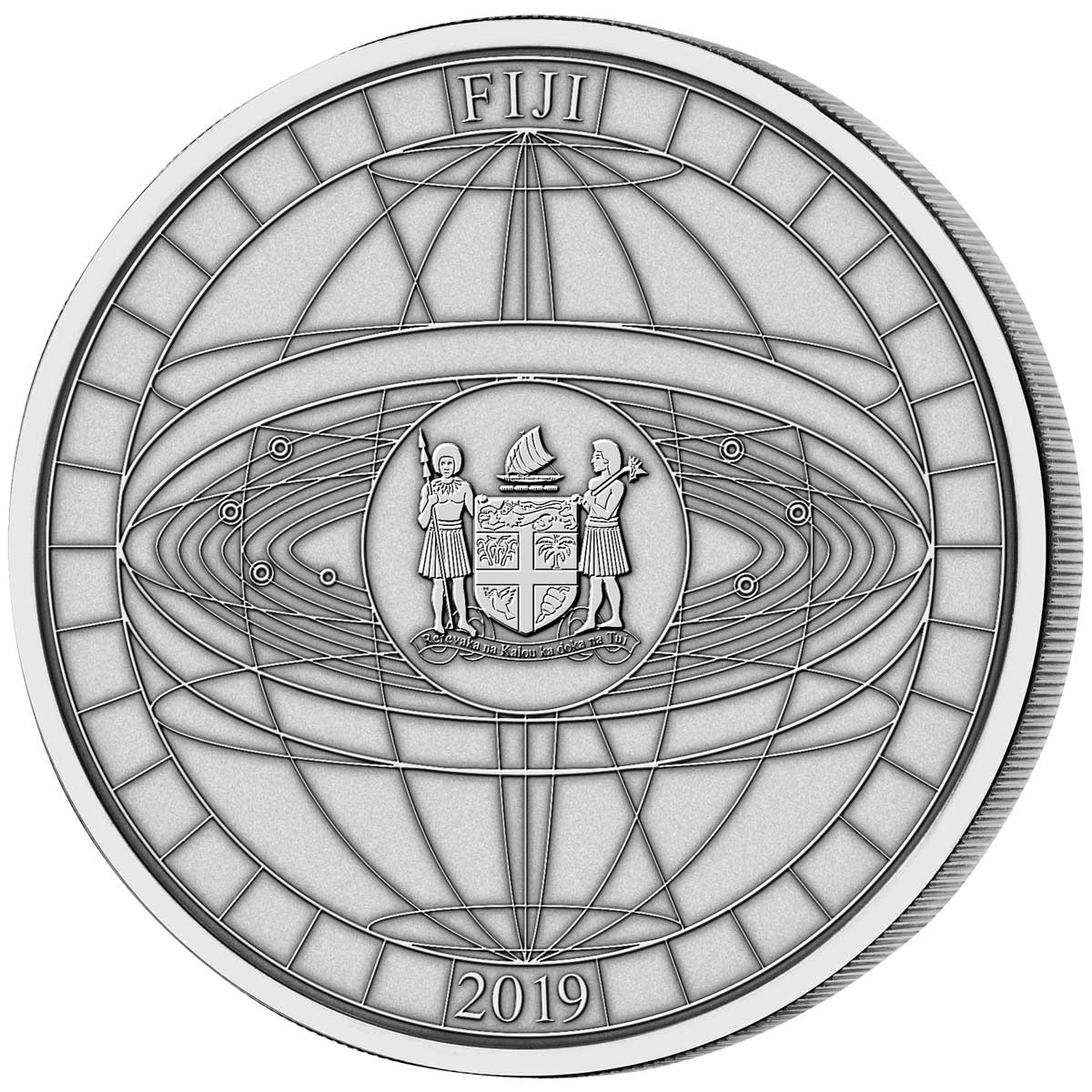ANA 2019: Silver and titanium combine to celebrate the Titans of Spaceflight on MDM’s 1/2kg coin
We’ve already covered a substantial number of the many coins issued to mark the 50th anniversary of the Apollo 11 moon landing, but there have also been a few issues that, while they’ve incorporated the mission, have had a wider focus. An interesting addition to the market is MDM’s new half-kilo silver coin that remembers not only the moon landing, but also a few other firsts in the early history of spaceflight.
At its heart is 500 grams of fine silver in a standard coin format. The depth and complexity of strike is fairly unassuming, although the stylised orbital trajectories on the obverse with a Fijian national emblem at its centre, is pretty neat. So what’s the differentiating design element here?
MDM are second only to the British Pobjoy Mint for their work with titanium as a commemorative coin metal, but this is the first time we’ve seen it embedded into the surface of a silver coin. Never one to dabble, MDM have actually embedded four of them in the reverse face of this giant 100mm diameter coin called Titans of Spaceflight. Titanium is apparently quite adept at taking on specific colours, so each of the four pills differs from the others in shade. Four landmark events are depicted which we’ve detailed further down, but all seem worthy of inclusion.
Just 99 of these will be produced and they will come presented in a box with a certificate of authenticity. Given the specification and limited mintage, this is clearly not going to be at the bargain basement end of the selection for this anniversary, so expect to pay around €1,200 for one. Check out our sponsors for one as we know at least a couple of them will offer it.
CORRECTION: This is a 500-gram coin and not a kilo. The mistake is entirely mine. Apologies.
TITANS OF SPACEFLIGHT
THE FIRST ANIMAL IN ORBIT: On 03 November 1957, the Soviet Union launched Sputnik 2. On board was Laika, a young Siberian husky dog who had been trained to eat to eat and survive in the tiny capsule. Becoming the first animal to orbit Earth, little Laika, dubbed Muttnik in the US, sadly perished in a short space of time.
THE FIRST MAN IN SPACE: Yuri Alekseyevich Gagarin, on board Vostok 3KA-3 (Vostok-1), blasted off from Baikonur Cosmodrome on 12 April 1961 and launched into orbit. The five first-stage engines fired until the first separation event,when the four side-boosters fell away, leaving the core engine. The core stage then separated while the rocket was in a suborbital trajectory,and the upper stage carried it to orbit. Just 108 minutes later, Vostok-1 made its journey back to Earth, carrying Gagarin to Kazakhstan. He became an international celebrity and was awarded the Hero of the Soviet Union, amongst many other accolades.
This was Gagarin’s only flight into space, as the Soviet Union didn’t want to risk its new international hero, although he was the backup astronaut on the Soyuz-1 mission. That one ended in tragedy with the death of Gagarin’s friend, Vladimir Komarov. Gagarin himself was killed in 1968 when a Mig-15 he was piloting crashed near Kirzhach.
THE FIRST WOMAN IN SPACE: Just over five years had passed since Gagarin’s epic flight when the first woman, Valentina Vladimirovna Tereshkova, lifted off in Vostok 6. Leaving Earth on 16 June 1963, she spent three days in space and orbited the Earth 48 times. She remains to this day the only woman to have undertaken a solo mission to space. She went into politics and remains active as a member of the national State Duma to this day, at aged 82.
THE FIRST MAN ON THE MOON: One small step for [a] man, one giant leap for mankind. With these words, astronaut Neil Armstrong opened up the next phase in human exploration by stepping from the Apollo 11 lunar lander onto the surface of the Moon. Joined 20 minutes later by Buzz Aldrin, and watched overhead by designated driver, Michael Collins, this was an event that was watched around the world with absolute admiration.
It was July 20, 1969, at 20:17 UTC that the lunar module Eagle touched down in the Sea of Tranquility, and six hours later Armstrong set foot on the surface. Along with Aldrin, they spent around 135 minutes walking on the lunar surface and collected a little more than 21 kg of material to return to Earth. Including their time in the module, they spent 21½ hours on the Moon.The mission to the Moon was called Apollo 11, and started with the launch of a Saturn V rocket from Kennedy Space Center on Merritt Island, Florida, on 16 July at 13:32 UTC and was the fifth manned mission of NASA’s Apollo program.
| SPECIFICATION | |
| DENOMINATION | $100 (Fiji) |
| COMPOSITION | 0.999 silver |
| WEIGHT | 500 grams (0.5kg) |
| DIMENSIONS | 100.0 mm |
| FINISH | Antique |
| MODIFICATIONS | Titanium inlays |
| MINTAGE | 99 |
| BOX / COA | Yes / Yes |





Leave A Comment